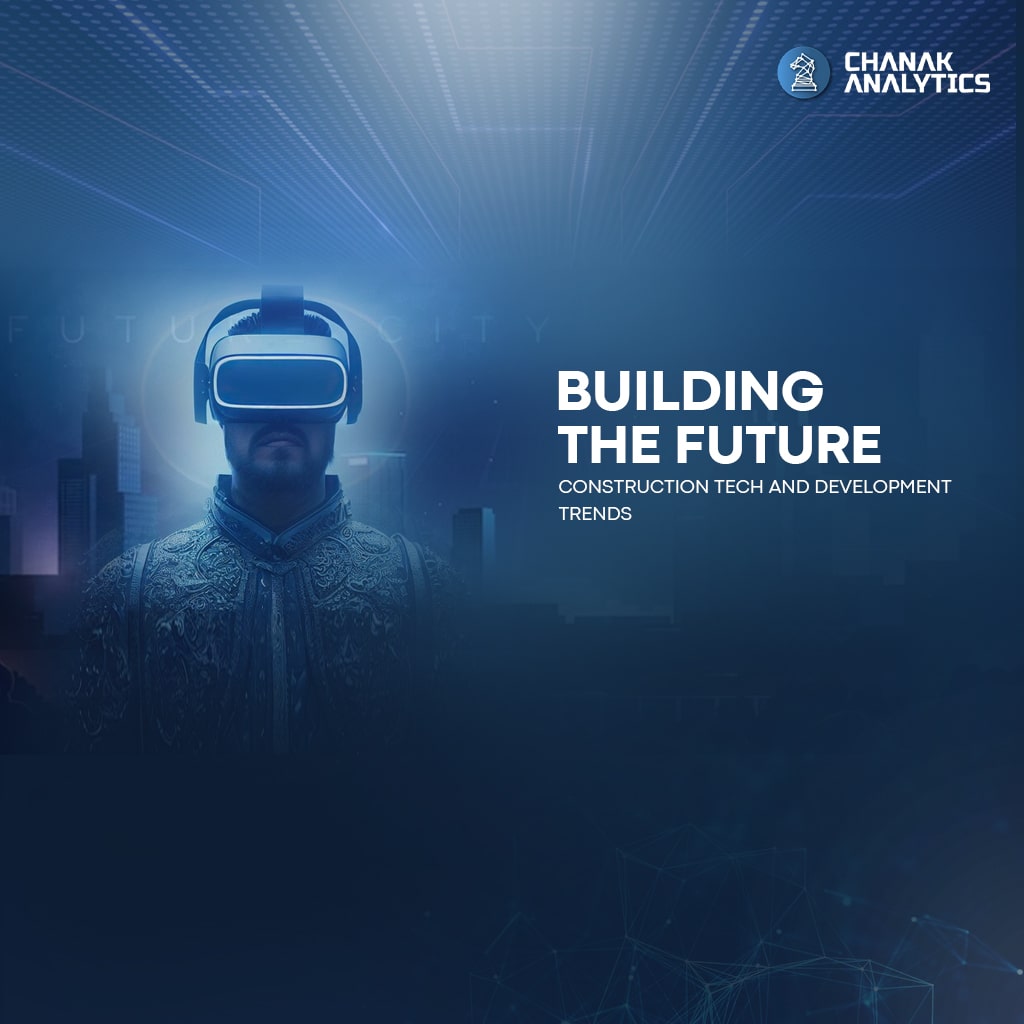Building the Future: Construction Tech and Development Trends


Construction technology is truly revolutionising the engineering and construction industries for good! Innovations in this space are heavily increasing project efficiency. It is also improving worker safety and reducing environmental impacts. Artificial intelligence project management and 3D concrete printing are just two examples of how technology is transforming the way we organise and construct buildings and infrastructure! Technologically smart buildings, modularization, and even sustainable technologies are becoming the new standard! As the industry evolves, investing in cutting-edge technology might help your company gain a competitive advantage. Let us take a look at some of the breakthroughs impacting the future and making projects faster, safer, and way more cost-effective than before.
How is technology shaping the construction industry?
As time passes, construction innovations are heavily increasing the efficiency and accuracy of the engineering and construction industries. Extremely efficient tools such as Building Information Modelling (BIM), unmanned aerial vehicles (UAV), and 3D printing are making project management easier and less expensive. Robotics and automation are speeding up construction while ensuring activities are executed safely and consistently. These technologies not only increase production but also enable more sustainable projects. As technology advances, the sector will achieve new levels of creativity and efficiency, building a better future through smarter, safer, and more sustainable design and construction. Stay competitive by adopting these eight trends.
How Can Construction Technology Boost Your Development Projects?
The idea of investing in construction technology is extremely beneficial at present. It offers countless benefits and advantages. Here are a few of our favourites:
- Increased Efficiency: Automation and innovative tools can complete tasks with less time and manpower required.
- Worker Safety: Drones and wearable technology can survey job sites for potential threats and dangers.
- Accuracy and Quality: 3D modelling and BIM ensure detailed visualisations of projects and help to reduce mistakes.
- Virtual Reality: Give owners, engineers, and contractors a vivid walkthrough of the final design to improve the decision-making process and client satisfaction.
Where is construction technology headed?
The construction industry is rapidly changing—now more than ever before! Newer and smarter technologies are making waves every day. Here are some major trends to watch out for:
- Virtual Reality: Imagine walking through a structure before it’s even built! VR helps designers get a more accurate view of the project. This helps in improving the outcome.
- Drones: These flying robots can survey sites, monitor progress, and carry out safety inspections. What more could you ask for?
- 3D Printing: This technology is completely changing the way buildings are built. The construction time and costs are drastically reduced, and it’s eco-friendly as well! What’s not to like?
- Building Information Modelling (BIM): It is essentially a digital 3D model that helps all the players in the project, from architects to contractors and clients, understand the details of the building.
- Green Construction: The use of sustainable materials and processes is now the norm as the demand for new buildings to be environmentally friendly increases.
Automating Construction: The Future of Building

Robotics and automation are modernising the industry in many ways. Here are some key areas they’re improving:
- Increase productivity: from automated concrete roofs to robotic bricklayers, construction time is reduced thanks to these machines that work faster and more accurately.
- Enhanced safety: robots can carry out hazardous tasks, which eliminates the need to put human workers in danger.
- Cost savings: with less labour required, costs are decreased, and material waste is reduced thanks to these machines.
- Consistency and quality: many of these robots and automation tools use precise technology that guarantees quality results.
These technologies are modernising construction sites, turning them into smart working environments. Investing in robotics and automation will ensure the industry continues to grow well into the future.
The power of 3D printing
3D printing is offering the construction industry innovative solutions that greatly improve productivity. Some key benefits are:
- Speed and Efficiency: 3D printing takes the data of a building design and produces the parts needed much faster than conventional methods, thus decreasing construction time.
- Cost-effective: This technology reduces material waste and the need for labour, thus decreasing the overall project cost.
- Customisation: 3D printing caters to the unique needs of a building, allowing for complex designs and structures that would be difficult to achieve with conventional methods.
- Sustainability: 3D printing uses environmentally friendly materials that encourage green construction.
How Are Virtual and Augmented Realities Changing the Industry?
Virtual and augmented reality (VR and AR) offer smart tools that can transform the construction industry by improving processes and results.
• Virtual Reality in Construction
VR offers immersive simulations that allow architects and engineers to experience the entire project before its construction. It helps them detect any design inaccuracies and correct mistakes earlier in the process. VR also facilitates virtual walkthroughs that enhance collaboration between teams and stakeholders.
• Augmented Reality in Construction
AR places digital information over physical scenarios, delivering data and instructions to workers on the field in real-time. It offers a rich and productive experience with precise directions for installations, inspections, and more.
VR and AR will redefine the construction industry as we know it and make every project more productive and profitable.
Revolutionising Construction with IoT
From equipment to buildings, the Internet of Things (IoT) is changing the landscape of the construction sector by improving productivity and efficiency.
- Smart Equipment: The IoT can monitor machinery and tools in real-time, predicting when maintenance is required and optimising their performance.
- Safety and Security: Sensors can connect workers to the system, tracking their whereabouts for safety and monitoring equipment for signs of theft.
- Remote Monitoring: Managers can check on the progress of construction projects remotely and respond instantly to any changes in schedules or the allocation of resources.
- Energy Efficiency: IoT devices can monitor and regulate energy use, cutting bills and waste.
The construction industry can save precious time and resources by adopting IoT, preventing downtime, and boosting productivity. The future of construction is smarter, safer, and greener with the Internet of Things.
How is artificial intelligence revolutionising construction?
Artificial intelligence is transforming the face of the construction industry, ensuring a future built on efficiency and precision. Here are some ways AI is changing the sector:
• Automated Project Management
From scheduling to monitoring progress and allocating resources, AI can optimise entire construction projects to ensure they are completed on time and within budget.
• Predictive Analytics
Problems can cost precious time and resources. AI can sift through data to identify potential problems and suggest solutions to avoid them.
• Robotic Automation
AI-powered robots are already building homes by performing tasks such as bricklaying and welding, using advanced technology for precision in their movements.
• Smart Safety
AI can support safety measures by monitoring site conditions and warning workers of potential dangers.
AI in construction is not just the next big thing; it’s the new bricks and mortar of the buildings of tomorrow.
Can sustainable construction technology build a better future?
The future of construction is sustainable, and the role of technology cannot be underestimated. Sustainable construction practices are key to building efficiently, economically, and responsibly for the environment and society at large. For example:
- Green Building Materials: Eco-friendly materials are used to reduce harm to the environment.
- Energy Efficiency: Smart technologies are used to reduce energy consumption.
- Waste Reduction: Techniques like modular construction are used.
- Renewable Energy Integration: This is done by utilising solar power, wind, etc.
- Smart Home Solutions: IoT and automation are often used for greater comfort and efficiency.
Navigating Construction Technology: Challenges and Considerations
As with any other technology, construction technology has its limitations and drawbacks. Before adopting any construction technology, builders must consider the following:
- Cost and Investment: Sophisticated technologies need proper setup, which may call for heavy investment.
- Training and Skill Development: Workers may have to be trained to handle sophisticated machinery and tools.
- Compatibility and Integration: New technology must be well integrated with current systems.
- Data Security and Privacy: Sensitive project information must be protected from cyber threats and hackers.
- Regulatory Compliance: Local regulations and safety standards must be considered.
- Maintenance and Support: Proper maintenance and technical support are required to keep things functioning.
Navigating the limitations and drawbacks of construction technology is imperative for the industry’s growth.
Building Tomorrow: Innovations in Construction Technology

The world is changing fast, building new things and ways. Here is a quick look at some futuristic innovations:
• Robotics and Automation
Machines are already making a difference, from making things in 3D to trucks that drive alone. They make work faster and cost less.
• Green Materials
The use of made-again steel, fake wood, and other things that keep going is growing.
• Artificial Intelligence
Using AI often aids in making plans and timing better and safer.
• Virtual and Augmented Reality
It is changing how designers see things and letting them work together and have real experiences.
• Internet of Things (IoT)
Machines using IoT are helping make things safer and let numbers be kept and shared quickly at work.
In the next few years, it will be very essential for groups to change with these innovations to stay in the big fight and do things on time and with the right money.
Looking Ahead: Innovations in Construction Technology and Development Trends
The future of building technology is full of excitement and will change the game for everyone in the building field. As we move into this new era, it’s clear that new ideas and technology will drive the most bold building projects in the coming years. AI, IoT, and easy-to-build designs are some of the key trends making the future of building work look so good. These tech tools will make building work faster, do more, and, most importantly, be kinder to the planet.
As projects get bigger and more complex, new technology and planned work methods will help cut down on waste and make it safer for workers. At Chanak Analytics, we’re set to help make this change easier with our top-notch digital tools and all-in-one platforms that match these trends well. Let’s work together to make a brighter and smarter future where we use technology to make our cities more efficient, green, smart, and connected like never before.
Join the community
Join our 400,000+ person community and contribute to a more private and decentralized internet. Start for free.


